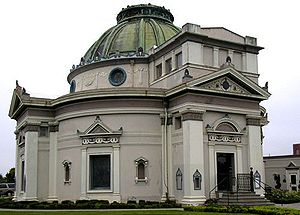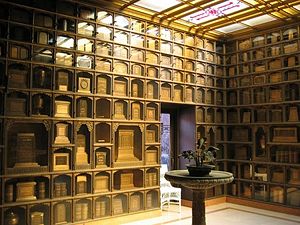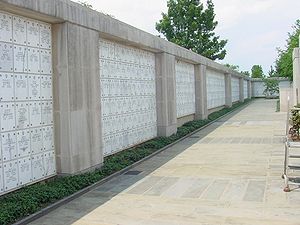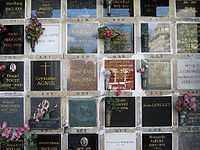
Columbarium
Encyclopedia


Cremation
Cremation is the process of reducing bodies to basic chemical compounds such as gasses and bone fragments. This is accomplished through high-temperature burning, vaporization and oxidation....
urn
Urn
An urn is a vase, ordinarily covered, that usually has a narrowed neck above a footed pedestal. "Knife urns" placed on pedestals flanking a dining-room sideboard were an English innovation for high-style dining rooms of the late 1760s...
s (i.e. urns holding a deceased’s cremated
Cremation
Cremation is the process of reducing bodies to basic chemical compounds such as gasses and bone fragments. This is accomplished through high-temperature burning, vaporization and oxidation....
remains). The term comes from the Latin
Latin
Latin is an Italic language originally spoken in Latium and Ancient Rome. It, along with most European languages, is a descendant of the ancient Proto-Indo-European language. Although it is considered a dead language, a number of scholars and members of the Christian clergy speak it fluently, and...
columba (dove) and originally referred to compartmentalized housing for doves and pigeons (see dovecote
Dovecote
A dovecote or dovecot is a structure intended to house pigeons or doves. Dovecotes may be square or circular free-standing structures or built into the end of a house or barn. They generally contain pigeonholes for the birds to nest. Pigeons and doves were an important food source historically in...
).
The Columbarium of Pomponius Hylas
Columbarium of Pomponius Hylas
The Columbarium of Pomponius Hylas is a 1st century AD Roman columbarium, situated near the Porta Latina on the Via Appia, Rome, Italy. It was discovered and excavated in 1831 by Pietro Campana....
is a particularly fine ancient Roman example, rich in frescoes, decorations and precious mosaics. Roman columbaria were built underground.
Today's columbaria can be either free standing units, or part of a mausoleum
Mausoleum
A mausoleum is an external free-standing building constructed as a monument enclosing the interment space or burial chamber of a deceased person or persons. A monument without the interment is a cenotaph. A mausoleum may be considered a type of tomb or the tomb may be considered to be within the...
or another building. Some manufacturers produce columbaria that are built entirely off-site and brought to the cemetery by a large truck. Many modern crematoria
Crematory
A crematory is a machine in which cremation takes place. Crematories are usually found in funeral homes, cemeteries, or in stand-alone facilities. A facility which houses the actual cremator units is referred to as a crematorium.-History:Prior to the Industrial Revolution, any cremation which took...
have columbaria. Fine examples of these are the columbaria in Père Lachaise Cemetery
Père Lachaise Cemetery
Père Lachaise Cemetery is the largest cemetery in the city of Paris, France , though there are larger cemeteries in the city's suburbs.Père Lachaise is in the 20th arrondissement, and is reputed to be the world's most-visited cemetery, attracting hundreds of thousands of visitors annually to the...
in Paris and Golders Green Crematorium
Golders Green Crematorium
Golders Green Crematorium and Mausoleum was the first crematorium to be opened in London, and one of the oldest crematoria in Britain. The land for the crematorium was purchased in 1900, costing £6,000, and was opened in 1902 by Sir Henry Thompson....
in London.
In other cases, columbaria are built into church structures. One example is the Cathedral of Our Lady of the Angels
Cathedral of Our Lady of the Angels
The Cathedral of Our Lady of the Angels, also called "COLA" and the Los Angeles Cathedral, is a cathedral of the Roman Catholic Church in Los Angeles, California, United States...
(Los Angeles, California), which houses a number of columbarium niches in the mausoleum built into the lower levels of the Cathedral. The construction of columbaria within churches is particularly widespread in the Czechoslovak Hussite Church
Czechoslovak Hussite Church
The Czechoslovak Hussite Church is a Christian Church which separated from the Roman Catholic Church after World War I in former Czechoslovakia. It traces its tradition back to the Hussite reformers and acknowledges Jan Hus as its predecessor...
. An example can be seen at the Church of St Nicolas in Old Town Square (Prague)
Old Town Square (Prague)
Old Town Square is a historic square in the Old Town quarter of Prague in the Czech Republic at .Located between Wenceslas Square and the Charles Bridge, Prague's Old Town Square is often bursting at the seams with tourists in the summer. Featuring various architectural styles including the...
. In the Roman Catholic Church
Roman Catholic Church
The Catholic Church, also known as the Roman Catholic Church, is the world's largest Christian church, with over a billion members. Led by the Pope, it defines its mission as spreading the gospel of Jesus Christ, administering the sacraments and exercising charity...
, although traditional burial is still preferred, cremation
Cremation
Cremation is the process of reducing bodies to basic chemical compounds such as gasses and bone fragments. This is accomplished through high-temperature burning, vaporization and oxidation....
is permitted provided that the cremated remains are buried or entombed. As a result, columbaria can be found within some Catholic cemeteries.
Columbaria are often closely similar in form to traditional Buddhist temples which from ancient times have housed cremated ashes.
In Buddhism
Buddhism
Buddhism is a religion and philosophy encompassing a variety of traditions, beliefs and practices, largely based on teachings attributed to Siddhartha Gautama, commonly known as the Buddha . The Buddha lived and taught in the northeastern Indian subcontinent some time between the 6th and 4th...
, ashes of the deceased may be placed in a columbarium (in Japanese Buddhism, a nokotsudo), which can be either attached to or a part of a Buddhist temple or cemetery. This practice allows for the family of the deceased to visit the temple for the conduct of traditional memorials and ancestor rites.


See also
- Catacomb
- Charnel HouseCharnel houseA charnel house is a vault or building where human skeletal remains are stored. They are often built near churches for depositing bones that are unearthed while digging graves...
- CryptCryptIn architecture, a crypt is a stone chamber or vault beneath the floor of a burial vault possibly containing sarcophagi, coffins or relics....
- GraveGrave (burial)A grave is a location where a dead body is buried. Graves are usually located in special areas set aside for the purpose of burial, such as graveyards or cemeteries....
- MausoleumMausoleumA mausoleum is an external free-standing building constructed as a monument enclosing the interment space or burial chamber of a deceased person or persons. A monument without the interment is a cenotaph. A mausoleum may be considered a type of tomb or the tomb may be considered to be within the...
- ReliquaryReliquaryA reliquary is a container for relics. These may be the physical remains of saints, such as bones, pieces of clothing, or some object associated with saints or other religious figures...
- TombTombA tomb is a repository for the remains of the dead. It is generally any structurally enclosed interment space or burial chamber, of varying sizes...
- OssuaryOssuaryAn ossuary is a chest, building, well, or site made to serve as the final resting place of human skeletal remains. They are frequently used where burial space is scarce. A body is first buried in a temporary grave, then after some years the skeletal remains are removed and placed in an ossuary...

